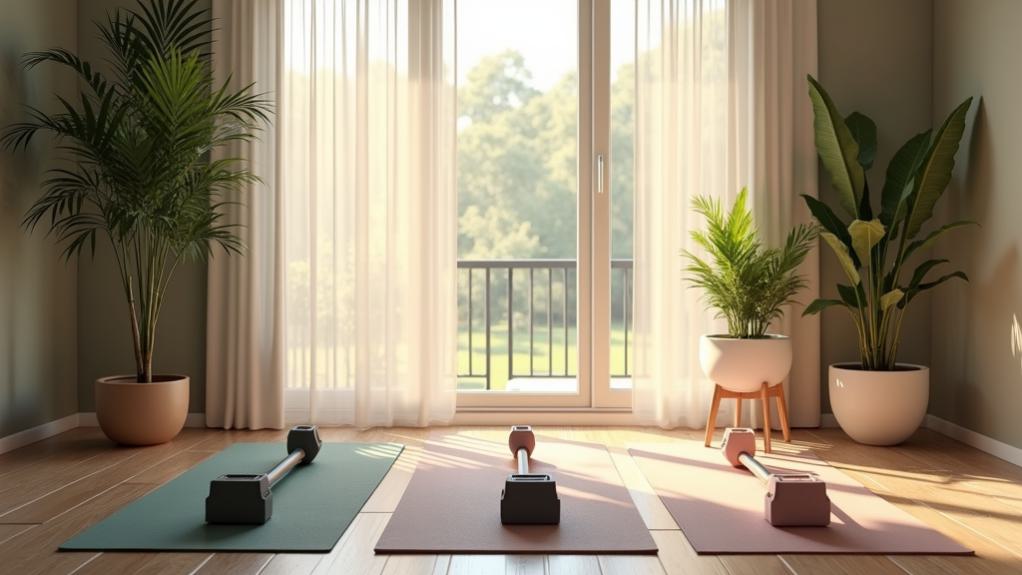Home workout plans for midlife women should emphasize strength, flexibility, and heart health. Aim for at least 150 minutes of moderate-intensity exercise each week. Combine cardio, strength training, and flexibility routines for a balanced approach.
Try total body workouts lasting about 35 minutes, incorporating bodyweight exercises and resistance bands. Don’t forget to prioritize warm-ups and cool-downs to prevent injuries. High-Intensity Interval Training (HIIT) can be a great time-saver while effectively burning fat.
Remember, focusing on form is essential as you strengthen your body. If you keep going, you’ll uncover even more strategies to thrive in your fitness journey.
Key Takeaways
- Aim for at least 150 minutes of moderate-intensity exercise weekly, focusing on total body workouts lasting around 35 minutes.
- Combine cardiovascular exercises, strength training, and flexibility routines for comprehensive health benefits.
- Incorporate circuit training or HIIT sessions for efficient fat loss and maximum workout intensity in 20-30 minutes.
- Prioritize warm-ups and cool-downs to prevent injuries and aid in recovery after workouts.
- Include resistance training at least twice a week to enhance muscle strength and support bone health.
Getting Started With Exercise
How do you begin your fitness journey in midlife? Start by aiming for at least 150 minutes of moderate-intensity exercise each week. This should include a mix of cardiovascular and resistance training, which is vital for your overall health.
To ease into it, begin with 20-30 minute workouts most days. This helps establish a consistent routine and makes the process feel manageable.
Focus on total body workouts that you can complete in about 35 minutes. Incorporate bodyweight exercises, free weights, and resistance bands to keep things interesting and to build strength effectively. Weight training is essential, as it enhances muscle mass and boosts metabolism, which can be particularly beneficial in midlife.
Don’t forget to prioritize rest and recovery. Allow adequate time between workouts to support muscle growth and prevent injuries.
As you become more comfortable, gradually increase the duration and intensity of your exercise sessions. This steady progression will keep you motivated and help you reap the full benefits of your fitness journey.
Effective Workout Structure
Establishing a consistent exercise routine is just the beginning; having an effective workout structure is what will truly propel you toward your fitness goals. For midlife women, combining cardiovascular exercises, strength training, and flexibility routines is essential for overall health and well-being.
Aim for at least 150 minutes of moderate-intensity aerobic activity each week, supplemented with strength training for women at least twice weekly. This approach enhances muscle mass and bone density, combating age-related muscle loss.
When structuring your workouts, consider incorporating 2 to 6 sets of 8-12 repetitions for strength exercises, focusing on major muscle groups. This not only improves functional strength but also promotes a balanced physique.
To maximize efficiency, utilize circuit training or supersets, allowing minimal rest between exercises to keep your heart rate elevated.
Don’t forget to include warm-ups and cool-downs to prevent injuries. Additionally, embrace progressive overload by gradually increasing your weights or repetitions over time.
Fat-Burning Strategies

When it comes to torching fat efficiently, incorporating a variety of strategies can make all the difference for midlife women. One of the most effective methods is High-Intensity Interval Training (HIIT). This approach burns more fat compared to steady-state cardio, making it a smart choice for managing weight. You can engage in quick, high-intensity workouts lasting just 20-35 minutes, fitting perfectly into your busy schedule.
Incorporating total body workouts like medicine ball squats and kettlebell swings is essential as they engage multiple muscle groups simultaneously, enhancing your overall caloric expenditure.
Supersetting exercises—performing two back-to-back with minimal rest—can ramp up the intensity and promote greater fat loss.
Time-Efficient Workouts
After exploring effective fat-burning strategies, it’s clear that time-efficient workouts are a game-changer for midlife women juggling busy lives. You don’t need hours to achieve your fitness goals. Full-body workouts can be completed in as little as 35 minutes, making them perfect for your hectic schedule.
Consider incorporating circuit training, where you perform exercises back-to-back with minimal rest. This method enhances calorie burn while saving you precious time.
High-intensity interval Training (HIIT) sessions can also yield significant fat loss benefits in just 20-30 minutes, helping you maintain muscle mass without lengthy workouts.
Additionally, supersets—performing two exercises consecutively without rest—can maximize your workout intensity and efficiency.
If you prefer a quick yet effective approach, try kettlebell workouts, which can be designed to fit into a 20-minute session, targeting both fat loss and strength training.
Common Workout Mistakes

When starting a new workout routine, it’s easy to make mistakes that can hinder your progress and even lead to injuries.
You might skip warm-ups, ignore proper form, or forget to incorporate rest days, thinking you’re pushing yourself to be stronger.
Let’s explore these common pitfalls so you can maximize your results and stay motivated on your fitness journey.
Overtraining and Fatigue
Overtraining can be a silent saboteur of your fitness journey, especially for midlife women. When you push beyond your body’s ability to recover, it can lead to fatigue, decreased performance, and increased risk of injury. To prevent this, listen to your body and prioritize recovery.
Here’s a quick look at the signs of overtraining and their emotional impact:
| Signs of Overtraining | Emotional Impact |
|---|---|
| Persistent muscle soreness | Frustration and discouragement |
| Elevated resting heart rate | Anxiety and worry |
| Sleep disturbances | Irritability |
| Mood changes | Loss of motivation |
| Increased fatigue | Feelings of helplessness |
Make sure to include at least one rest day per week and focus on proper nutrition and hydration. Gradually increase workout intensity; sudden jumps in volume can lead to fatigue and injuries, especially as recovery slows in midlife.
If you find fatigue lingers despite rest, it’s time to reassess your routine. Balance is key—embrace recovery as part of your fitness journey to keep moving forward with confidence!
Ignoring Form and Technique
Recovery is just as important as the workouts themselves, but even with the best intentions, many midlife women overlook proper form and technique during their exercise routines.
Ignoring form can lead to injuries, particularly as decreased flexibility and balance become more common. You want to engage the targeted muscle groups effectively while minimizing stress on your joints.
Here are some tips to help you maintain proper form:
- Start with lighter weights: Focus on mastering your technique before adding resistance.
- Keep your back straight: This is vital during exercises like squats to protect your spine.
- Engage a fitness professional: An exercise physiologist can provide invaluable guidance on form.
- Use instructional resources: Videos or apps can help you visualize proper technique.
Skipping Warm-Up and Cool-Down
Often, many midlife women underestimate the importance of warming up and cooling down during their workout routines. Skipping these vital phases can lead to injuries and hinder your overall progress. A proper warm-up prepares your muscles and joints by gradually increasing your heart rate and blood flow. It should last about 5-10 minutes and include dynamic stretches and light aerobic exercises.
On the flip side, neglecting the cool-down phase can result in muscle soreness and stiffness. This phase, which also lasts 5-10 minutes, helps lower your heart rate and promotes recovery through static stretching.
| Warm-Up Benefits | Cool-Down Benefits |
|---|---|
| Prepares muscles for activity | Reduces muscle soreness |
| Increases heart rate gradually | Helps lower heart rate |
| Enhances performance | Promotes flexibility |
| Reduces risk of injuries | Prevents tightness |
| Improves overall workout effectiveness | Aids in recovery |
Incorporating warm-up and cool-down routines is essential for your long-term fitness gains, especially as you navigate age-related changes. So, don’t skip these vital steps—your body will thank you!
Strength Training Benefits
Strength training is a game changer for your muscle strength and bone health.
By incorporating it into your routine just a few times a week, you can combat muscle loss and enhance bone density, keeping you strong and independent.
Plus, the benefits extend beyond the physical, boosting your overall well-being as you age.
Muscle Strength Improvement
As you navigate midlife, building and maintaining muscle strength becomes essential for your overall well-being. Strength training, especially using resistance bands, can help combat the muscular strength loss of 30%-40% that often occurs between ages 30 and 80.
Here are some key benefits of improving muscle strength:
- Enhanced functional strength: You’ll find daily activities, like lifting groceries, become easier and more manageable.
- Improved body composition: Regular strength training helps you manage your weight and reduce body fat effectively.
- Boosted metabolism: Engaging in resistance training can elevate your metabolism, aiding in weight control.
- Mental health support: Strength training can improve self-efficacy while reducing anxiety and depression rates.
Incorporating strength training into your routine isn’t just about aesthetics; it’s about empowering yourself to embrace life fully.
By focusing on muscle strength improvement, you set the foundation for a more active, confident, and fulfilling midlife experience.
Remember, every little bit counts, so start with what feels comfortable, and gradually increase the intensity.
You’ve got this!
Bone Health Enhancement
In midlife, prioritizing bone health is essential for maintaining your overall vigor and independence. One of the most effective ways to enhance bone density is through strength training.
For women over 50, engaging in resistance training at least twice a week can meaningfully reduce the risk of osteoporosis and fractures, which affect one in two women post-menopause.
Research shows that strength training can increase bone mass by 1%-2% per year in postmenopausal women, providing a critical protective effect against age-related bone loss. Additionally, lifting weights helps combat the natural decline in metabolism that typically occurs with aging, making it important for maintaining metabolic health.
Not only does strength training boost your bone density, but it also enhances functional strength, allowing you to perform daily activities with ease. This improvement in mobility can greatly enhance your overall quality of life and independence as an older adult.
Recommended At-Home Exercises

Finding effective at-home exercises can transform your fitness routine, especially for midlife women looking to stay strong and active. Incorporating bodyweight exercises into your physical activity can help build strength without needing any equipment.
Here are some recommended exercises to try:
- Forearm Plank: Engage your core and shoulders by holding for 30 seconds.
- Modified Push-ups: Perform from a kneeling position to safely strengthen your arms and core.
- Basic Squats: Target your glutes, quads, and hamstrings while ensuring proper knee alignment.
- Single Leg Hamstring Bridge: Improve balance and strengthen your hamstrings.
Aim for 8-12 repetitions of each exercise, allowing for 30-60 seconds of rest between sets.
Remember, focusing on form and breathing is essential to prevent injuries and maximize your benefits, especially as you increase weight and intensity over time.
Incorporate these exercises into your routine, and you’ll not only enhance your strength but also boost your confidence. Staying active at home can be both enjoyable and rewarding, so start today and embrace the journey toward a healthier you!
Menopause-Specific Fitness Tips
Staying active is particularly important during menopause, as your body undergoes significant changes that can impact your fitness journey. Regular exercise can help you maintain a healthy weight and manage symptoms. Focus on incorporating strength training at least twice a week to combat muscle loss, which can be as much as 10% during this time. High-intensity interval training (HIIT) is also beneficial, effectively preserving muscle mass and alleviating menopause symptoms.
Here’s a quick reference table to guide your fitness routine:
| Exercise Type | Frequency | Benefits |
|---|---|---|
| Strength Training | 2 times a week | Mitigates muscle loss |
| HIIT | 2-3 times a week | Preserves muscle and relieves symptoms |
| Moderate Aerobic Activity | 150 minutes weekly | Supports heart health and weight management |
| Flexibility & Balance | 2-3 times a week | Improves mobility and reduces fall risk |
| Consistent Activity | Regularly | Enhances overall well-being |
Conclusion
As you commence your fitness journey, remember that each small step can lead to monumental changes in your health and well-being.
You can feel as unstoppable as a superhero with the right workout plan. Embrace the power of strength training, stay mindful of common pitfalls, and tailor your routine to your unique needs. You’ve got the tools to thrive during midlife, so get moving and watch your confidence soar! Your best self is just a workout away!
Join our list
Subscribe to our mailing list and get interesting stuff and updates to your email inbox.

